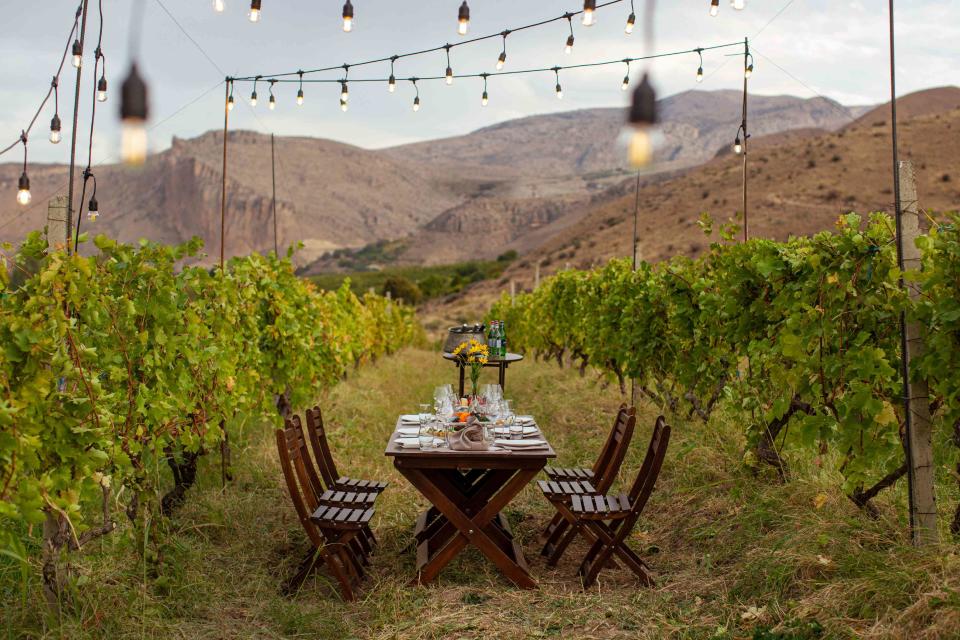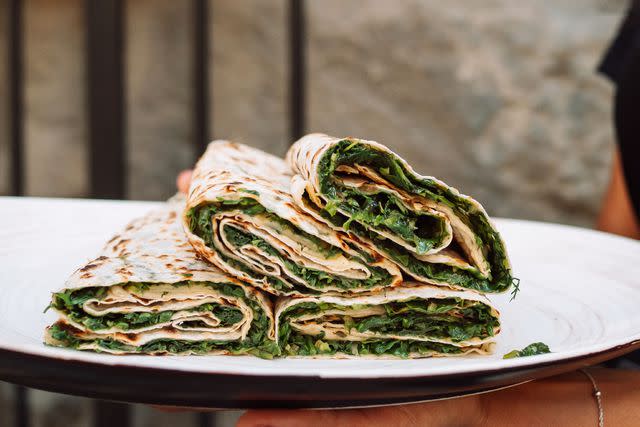A Vibrant New Culinary Scene Is Rooted in Armenia’s Ancient Winemaking Culture
Ancient vines, new wines.

2492 Travel
Just 90 minutes south of Yerevan, Armeniaâs capital, lies the Areni wine region, where visi- tors can book im- mersive food and wine experiences.The first wine bar to open in Yerevan, the capital of Armenia, in 2012 seemed destined to fail. In Vino’s location on sleepy Saryan Street did it no favors; it was surrounded by electronics stores. And then there was the drinking culture, a legacy of Soviet times: Modern Armenians were hopelessly hooked on fruit vodka. Worse still, the wine bar’s then-19-year-old cofounder, Mariam Saghatelyan, had “only about 10 drinkable Armenian bottles” to offer.
“People would open the door, walk in, and say, ‘Oh, wine?’ and then leave,” says Saghatelyan. “Even the people whose wine we were selling told us it was never going to work.”
And yet, work it did. In fact, In Vino’s success helped launch a renaissance in Armenian wine.
A decade later, those who arrive early enough to secure a table at the wine bar can choose from more than 250 Armenian bottles. Millennials on date nights throng the twice-weekly wine tastings. And Saryan Street? “It’s a see-and-be-seen kind of place,” Aimee Keushguerian, a winemaker and managing director at the Armenian winery incubator WineWorks, told me as we sat together at In Vino watching Saghatelyan entertain the crowds. “Actually, they call it ‘Wine Street’ now,” she added, since all the electronics stores have been replaced by bottle shops, cafés, and wine-forward restaurants.

2492 Travel
Trinity Canyon Vineyards offers a traditional feast at its winery.“It’s only in the last decade that we’ve been making quality wine, but we have incredibly old vines and grapes you won’t find anywhere else on earth,” Keushguerian said.
Armenians like to say that Noah crash-landed his biblical ark at Mount Ararat, the snowcapped volcano looming over Yerevan, before planting the earth’s first vineyards. Whether that’s fact or fable became irrelevant following the 2007 discovery of a 6,100-year-old winery—the world’s oldest—in a cave in Areni, 90 minutes south of the capital. The dig at Areni-1, as the cave is known, yielded clay vessels, a grape press, and bulbous fermentation vats called karases, all hidden within soaring cliffs, predating the first Egyptian pyramids by some 1,500 years.
Excitement over the discovery prompted the government to fund winemaking as a potential economic driver, using the nation’s history and 400-plus native grape varietals as a way to attract fresh talent. Over the past decade, cash and expertise have poured in from Armenia’s vast 7-million-strong diaspora, sowing the seeds for what is today a flourishing industry.
Nowhere is that more apparent than at Decant, a new bottle shop on Saryan Street, where you find innovation at play in bottles like Yacoubian-Hobbs’ Sarpina (crafted from an Armenian red grape, Areni), Krya’s Indigenous Blend (made using native yeasts and rare white varietals like Dolband and Garan Dmak), and Khme’s Karasi Orange (an amber skin-contact wine aged in clay amphorae).
Related:The Oldest Newest Wine Region in the World
“Armenia may be a very culturally conservative nation, but when it comes to wine, we’re not conservative at all,” said Decant’s owner, Artyom Mkrtchyan. He explained that, unlike neighboring Georgia, which has seamlessly carried its winemaking tradition from antiquity into the 21st century, Armenia begrudgingly pivoted to brandy amid the planned economy of the Soviet era (1920–1991). The decades-long disruption, he believed, may offer a surprising advantage: Armenian winemakers today are now less constrained by convention.
I sampled some of Mkrtchyan’s weekly wine picks and then followed the Wine Map of Armenia he gave me out to the encyclopedic new Wine History Museum of Armenia in the Aragatsotn province. Then, I spent a few days strolling Yerevan’s large, tree-lined boulevards, exploring, one meal at a time, how the rebirth of Armenian wine complemented a similar awakening in the city’s restaurants.

David Danielyan
Bottles line the walls at In Vino.At Mayrig, I found the beloved western Armenian specialty manti, tiny lamb dumplings that were latticed together almost like the textiles strung across the walls. At trendy Lavash, I found the labor-intensive dish ghapama, a whole stuffed pumpkin sweet with dried fruits, nuts, and rice, all cooked in a tandoor-like tonir oven. And everywhere I went, including the innovative yet cozy Tsaghkunk Restaurant, hidden behind stone walls in the countryside near Lake Sevan, I couldn’t help but order yet another round of tolma, stuffed grape leaves.
Each dish spoke to Yerevan’s 2,800-year history as a hub on ancient trade routes between Asia and Europe. Paired with Armenian wines, they showcased the growing appeal of Armenia’s capital, a city bubbling with innovation, yet grounded in a deep-rooted identity.
Take a day trip to Areni
“Wine is not just a drink for us,” says Narine Ghazaryan, co-owner of Momik Wines. “It’s part of our history, so we have a duty to protect it and show it to the world.” At her tasting room, which lies within sight of the Areni-1 cave in the Vayots Dzor province (a two-hour drive south of the capital), Ghazaryan does just that, exhibiting the town’s namesake Areni grape in both plummy reds and cherry-hinted rosés. Nearby Trinity Canyon Vineyards offers tastings of its natural and karas-aged bottles (including Voskehat Ancestors, an amber wine with hints of apricot) alongside traditional khorovats, feasts of grilled meats and vegetables, flatbreads, and more. Armenian travel company 2492 runs an immersive Wild Food Adventure high on a grassy clifftop overlooking the 13th-century Noravank Monastery. Three-course meals, served alfresco, include regional specialties such as horats panir, a nutty goat cheese aged underground in clay pots. Paired wines come from adjacent vineyards.

2492 Travel
Lavash with spinach and herbs is a common snack.Getting there
Visitors from the U.S. can fly to Yerevan’s Zvartnots International Airport through European hubs like Paris or Frankfurt via airlines including Air France and Lufthansa, or through Middle Eastern hubs such as Doha or Dubai with Qatar Airways and Emirates. Visit armenia.travel and visityerevan.am for more information and resources for planning your trip.
Where to eat & drink in Yerevan
Lavash
Named for Armenia’s beloved flatbread, which bakes in a tonir oven, Lavash offers a tour de force of regional gastronomy, serving delicacies like ghapama (pumpkin stuffed with rice and dried fruits).
Mayrig
Mayrig prepares dishes like manti (lamb dumplings), which originated in areas of present-day Turkey. Walls lined with intricate carpets and vibrant ceramics give the place an unmistakably local character.
Renommée
Theatrical degustation-menu restaurants have recently popped up in Yerevan, including this newcomer from chef Karen Khachatryan, who plates dishes evoking a journey through the Armenian landscape.
Tsaghkunk Restaurant
Celebrated chef Arev Martirosyan decamped from the city to the nearby countryside to run this destination restaurant, a haven for progressive heritage cuisine located in a former canteen for Soviet farmers.
Mirzoyan Library
Hidden on an unassuming alleyway near English Park, this “library” holds the largest photographic collection in the Caucasus. It’s also an art gallery, coworking space, and bohemian cocktail lounge.
Minas Cocktail Room
There’s a perennial waitlist for the seven intimate tables at this cocktail bar decorated in bold murals from painter Minas Avetisyan.
Bar Phoenix
The flagship cocktail bar of brandy giant Ararat is home to career bartenders who possess the flair of a circus act.
Where to stay
The Alexander, A Luxury Collection Hotel
Yerevan’s first true international luxury hotel, opened in 2019, has an unrivaled contemporary polish with gold and silver accents, Armenian cross-stone designs, and geometric decor. Rooms from $350, marriott.com
Grand Hotel Yerevan
This property has the opulence to match its 100-year-old facade yet is wholly modern with contemporary art, an interior patio, and a rooftop pool. Rooms from $110, grandhotelyerevan.com
Republica Hotel
Pairing high design with low prices, the hotel offers a gastronomic journey through Armenian cuisine in its restaurant, Anoush. Rooms from $132, republicahotel.am
For more Food & Wine news, make sure to sign up for our newsletter!
Read the original article on Food & Wine.

